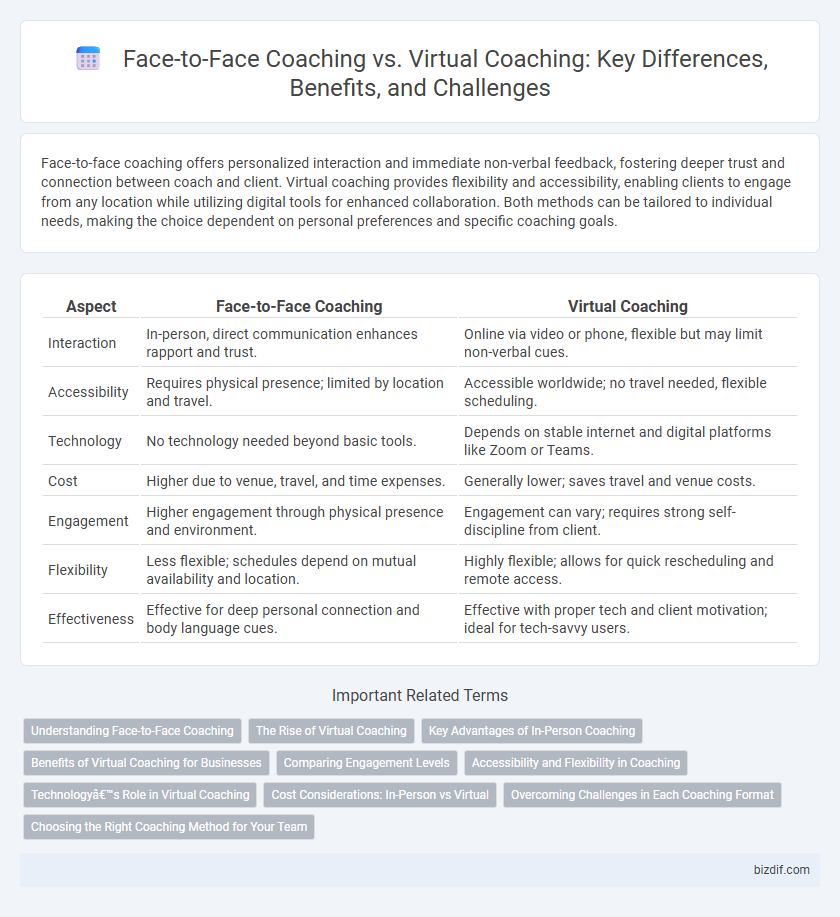Face-to-face coaching offers personalized interaction and immediate non-verbal feedback, fostering deeper trust and connection between coach and client. Virtual coaching provides flexibility and accessibility, enabling clients to engage from any location while utilizing digital tools for enhanced collaboration. Both methods can be tailored to individual needs, making the choice dependent on personal preferences and specific coaching goals.
Table of Comparison
| Aspect | Face-to-Face Coaching | Virtual Coaching |
|---|---|---|
| Interaction | In-person, direct communication enhances rapport and trust. | Online via video or phone, flexible but may limit non-verbal cues. |
| Accessibility | Requires physical presence; limited by location and travel. | Accessible worldwide; no travel needed, flexible scheduling. |
| Technology | No technology needed beyond basic tools. | Depends on stable internet and digital platforms like Zoom or Teams. |
| Cost | Higher due to venue, travel, and time expenses. | Generally lower; saves travel and venue costs. |
| Engagement | Higher engagement through physical presence and environment. | Engagement can vary; requires strong self-discipline from client. |
| Flexibility | Less flexible; schedules depend on mutual availability and location. | Highly flexible; allows for quick rescheduling and remote access. |
| Effectiveness | Effective for deep personal connection and body language cues. | Effective with proper tech and client motivation; ideal for tech-savvy users. |
Understanding Face-to-Face Coaching
Face-to-face coaching offers direct interpersonal interaction that fosters deeper trust and immediate feedback, essential for personalized development. The physical presence enables coaches to observe non-verbal cues such as body language and facial expressions, enhancing communication effectiveness. This traditional approach supports a tailored coaching experience that can adapt dynamically to the coachee's emotional and behavioral responses.
The Rise of Virtual Coaching
The rise of virtual coaching has revolutionized the coaching industry, offering greater accessibility and flexibility compared to traditional face-to-face sessions. Advanced video conferencing tools and digital platforms enable coaches to reach a global clientele, increasing engagement and personalized support without geographical limitations. Virtual coaching also reduces travel time and costs, making professional development more efficient and scalable.
Key Advantages of In-Person Coaching
In-person coaching fosters deeper personal connections through direct eye contact and immediate feedback, enhancing trust and communication effectiveness. The physical presence allows for better observation of non-verbal cues, facilitating tailored guidance and stronger rapport between coach and client. Furthermore, face-to-face sessions reduce technological interruptions, ensuring uninterrupted focus and engagement during coaching interactions.
Benefits of Virtual Coaching for Businesses
Virtual coaching offers businesses increased flexibility by allowing employees to access sessions from any location, reducing downtime and travel expenses. The use of digital tools enhances tracking progress and tailoring personalized development plans, promoting continuous learning. Scalability of virtual coaching enables companies to support a larger workforce efficiently, driving productivity and cost-effectiveness.
Comparing Engagement Levels
Face-to-face coaching fosters stronger engagement through direct eye contact, immediate feedback, and non-verbal cues that enhance communication effectiveness. Virtual coaching leverages digital tools and flexible environments, which may increase convenience but can reduce the depth of personal connection and attentiveness. Studies indicate that while virtual coaching offers accessibility, in-person sessions consistently generate higher motivation and sustained commitment from coachees.
Accessibility and Flexibility in Coaching
Face-to-face coaching provides direct interpersonal interaction, enhancing communication nuances and immediate feedback, which benefits clients seeking personalized, hands-on guidance. Virtual coaching expands accessibility by removing geographical barriers, allowing clients from diverse locations to engage with experts previously out of reach. Flexibility in scheduling and session formats in virtual coaching accommodates varying time zones and busy lifestyles, making coaching more adaptable to individual needs.
Technology’s Role in Virtual Coaching
Technology in virtual coaching leverages high-speed internet, video conferencing platforms like Zoom and Microsoft Teams, and interactive tools such as digital whiteboards for a dynamic learning experience. Advanced software enables real-time feedback, progress tracking, and personalized coaching plans, making virtual sessions as effective as face-to-face meetings. The integration of AI-driven analytics and virtual reality environments further enhances engagement and skill development remotely.
Cost Considerations: In-Person vs Virtual
Face-to-face coaching typically involves higher expenses due to travel, venue rental, and time commitments for both coach and client. Virtual coaching significantly reduces these costs by eliminating geographical barriers and enabling flexible scheduling through digital platforms. Organizations and individuals can achieve cost-efficiency while maintaining coaching effectiveness by opting for virtual sessions without sacrificing personalized interaction.
Overcoming Challenges in Each Coaching Format
Face-to-face coaching provides direct interaction, allowing coaches to read body language and build trust, yet may face challenges such as scheduling conflicts and geographical constraints. Virtual coaching overcomes location barriers and offers flexible timing but requires overcoming technology issues and fostering engagement without physical presence. Effective strategies include using reliable platforms, setting clear expectations, and incorporating interactive elements to enhance connection in both formats.
Choosing the Right Coaching Method for Your Team
Selecting the appropriate coaching method depends on your team's specific needs, communication style, and goals. Face-to-face coaching fosters direct interaction, immediate feedback, and stronger personal connections, ideal for enhancing collaboration and trust within teams. Virtual coaching offers flexibility, accessibility, and cost-effectiveness, making it suitable for remote or geographically dispersed teams seeking customized development plans without physical limitations.
Face-to-Face Coaching vs Virtual Coaching Infographic

 bizdif.com
bizdif.com